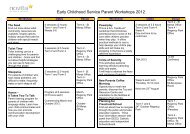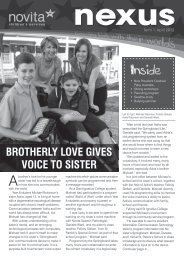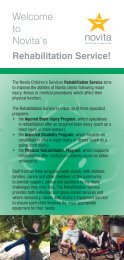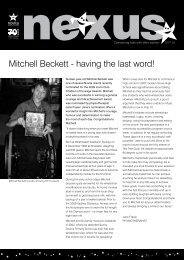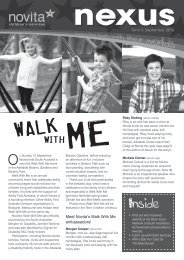Novita Research Report - 2004 to 2007 - Novita Children's Services
Novita Research Report - 2004 to 2007 - Novita Children's Services
Novita Research Report - 2004 to 2007 - Novita Children's Services
- No tags were found...
Create successful ePaper yourself
Turn your PDF publications into a flip-book with our unique Google optimized e-Paper software.
55ResultsImplicationsStatusThe instrument complies with the Standard requirements as follows:• able <strong>to</strong> measure and record speed up <strong>to</strong> 5m/s, with an accuracy of +/-0.1m/s, a samplerate greater than 60Hz and facility <strong>to</strong> detect 10% and 90% values of maximum speed• able <strong>to</strong> measure and record acceleration up <strong>to</strong> 5m/s2, with an accuracy of +/-0.2m/s2,a sample rate greater than 60Hz and a frequency response such that frequencies above30Hz are rejected.This instrument provides the labora<strong>to</strong>ry with the capacity <strong>to</strong> perform testing <strong>to</strong> theStandard test methods of ISO 7176-6. Given that Australian Standards are moving <strong>to</strong>wardsharmonisation with the International (ISO) standards, it is expected that this test methodwill soon be adopted as an Australian Standard for electric wheelchairs. Thus there is anexpectation that all chairs requiring Australian Standards compliance in the future will alsoneed <strong>to</strong> demonstrate compliance with the test method of ISO 7176-6.CompletedProject titleContribu<strong>to</strong>rsSummaryInvestigating the use of switches as inputs <strong>to</strong> powered wheelchair driving controlsand the associated risksChris Hern (Flinders University), David Hobbs, Rob Garrett, Jeff PriceIn the field of assistive technology (AT), using a switch is often the only way someone with adisability can make a selection and control a piece of equipment. From a risk managementperspective, switch integrity and performance was highlighted as a potential safety issue,particularly when the switch in question is used in a critical situation.If a switch activates a <strong>to</strong>y and it doesn’t work, the worst-case scenario is that that the clientdoesn’t receive the ‘cause and effect’ response they were expecting. However, the use ofswitches as inputs <strong>to</strong> powered wheelchair driving controls is becoming more popular as newand improved products emerge. This raises concerns as <strong>to</strong> the suitability of switches beingused in these applications, since switch failure in this circumstance could potentially result inserious injury. If the switch were <strong>to</strong> fail in the ‘off’ position, the user would be unable <strong>to</strong> controltheir wheelchair and be left stranded as a consequence. If the switch fails in the ‘on’ position,the user could be uncontrollably driven in<strong>to</strong> oncoming traffic or a stationary object.The aim of this project was <strong>to</strong> produce a minimum acceptable specification for switches thatare used as driving controls and evaluate existing switches against this specification.Using switch-adapted devices






